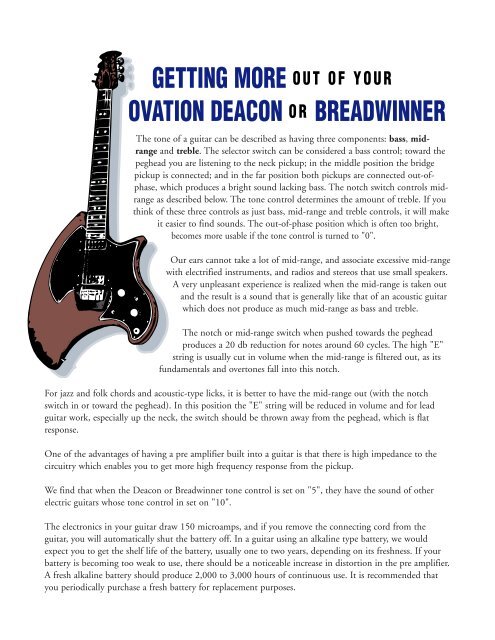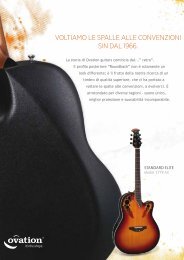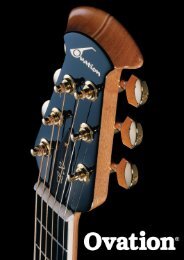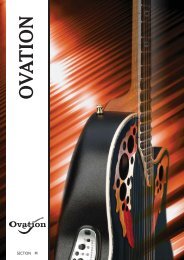getting more out of your ovation deacon or ... - Ovation Tribute
getting more out of your ovation deacon or ... - Ovation Tribute
getting more out of your ovation deacon or ... - Ovation Tribute
You also want an ePaper? Increase the reach of your titles
YUMPU automatically turns print PDFs into web optimized ePapers that Google loves.
GETTING MORE OUT OF YOUR<br />
OVATION DEACON OR BREADWINNER<br />
The tone <strong>of</strong> a guitar can be described as having three components: bass, midrange<br />
and treble. The select<strong>or</strong> switch can be considered a bass control; toward the<br />
peghead you are listening to the neck pickup; in the middle position the bridge<br />
pickup is connected; and in the far position both pickups are connected <strong>out</strong>-<strong>of</strong>phase,<br />
which produces a bright sound lacking bass. The notch switch controls midrange<br />
as described below. The tone control determines the amount <strong>of</strong> treble. If you<br />
think <strong>of</strong> these three controls as just bass, mid-range and treble controls, it will make<br />
it easier to find sounds. The <strong>out</strong>-<strong>of</strong>-phase position which is <strong>of</strong>ten too bright,<br />
becomes <strong>m<strong>or</strong>e</strong> usable if the tone control is turned to "0".<br />
Our ears cannot take a lot <strong>of</strong> mid-range, and associate excessive mid-range<br />
with electrified instruments, and radios and stereos that use small speakers.<br />
A very unpleasant experience is realized when the mid-range is taken <strong>out</strong><br />
and the result is a sound that is generally like that <strong>of</strong> an acoustic guitar<br />
which does not produce as much mid-range as bass and treble.<br />
The notch <strong>or</strong> mid-range switch when pushed towards the peghead<br />
produces a 20 db reduction f<strong>or</strong> notes around 60 cycles. The high "E"<br />
string is usually cut in volume when the mid-range is filtered <strong>out</strong>, as its<br />
fundamentals and overtones fall into this notch.<br />
F<strong>or</strong> jazz and folk ch<strong>or</strong>ds and acoustic-type licks, it is better to have the mid-range <strong>out</strong> (with the notch<br />
switch in <strong>or</strong> toward the peghead). In this position the "E" string will be reduced in volume and f<strong>or</strong> lead<br />
guitar w<strong>or</strong>k, especially up the neck, the switch should be thrown away from the peghead, which is flat<br />
response.<br />
One <strong>of</strong> the advantages <strong>of</strong> having a pre amplifier built into a guitar is that there is high impedance to the<br />
circuitry which enables you to get <strong>m<strong>or</strong>e</strong> high frequency response from the pickup.<br />
We find that when the Deacon <strong>or</strong> Breadwinner tone control is set on "5", they have the sound <strong>of</strong> other<br />
electric guitars whose tone control in set on "10".<br />
The electronics in <strong>your</strong> guitar draw 150 microamps, and if you remove the connecting c<strong>or</strong>d from the<br />
guitar, you will automatically shut the battery <strong>of</strong>f. In a guitar using an alkaline type battery, we would<br />
expect you to get the shelf life <strong>of</strong> the battery, usually one to two years, depending on its freshness. If <strong>your</strong><br />
battery is becoming too weak to use, there should be a noticeable increase in dist<strong>or</strong>tion in the pre amplifier.<br />
A fresh alkaline battery should produce 2,000 to 3,000 hours <strong>of</strong> continuous use. It is recommended that<br />
you periodically purchase a fresh battery f<strong>or</strong> replacement purposes.
Frequency Response Curves F<strong>or</strong> Conventional Passive Guitar Electronics<br />
1. Flat response is a term used to describe an electronic circuit which treats all frequencies <strong>or</strong> notes with equal<br />
volume. Connecting a pickup directly to an amplifier should produce flat response. However, the input impedance<br />
<strong>of</strong> most amplifiers causes some <strong>of</strong> the high-pitched notes to be lost.<br />
2. The tone control in conventional guitars filters away some <strong>of</strong> the midrange and most <strong>of</strong> the high frequency<br />
overtones. This loss <strong>of</strong> treble makes the instrument sound warmer. With passive electronics it is only possible to<br />
filter signal away, resulting in a certain amount <strong>of</strong> volume loss.<br />
3. On most guitars when the select<strong>or</strong> switch is in the middle position, both pickups are connected in-phase. Since<br />
the two pickups do not receive exactly the same inf<strong>or</strong>mation from the string, they are both in-phase and <strong>out</strong>-<strong>of</strong>phase<br />
at different notes, the final result being a sound compromise between the neck and bridge pickups, with a<br />
somewhat <strong>out</strong>-<strong>of</strong>-phase quality to the higher overtones.<br />
Frequency Response Curves F<strong>or</strong> Deacon And Breadwinner Active Electronics<br />
1. The input impedance <strong>of</strong> the pre amplifier built into the guitar is much higher than conventional guitar<br />
amplifiers, theref<strong>or</strong>e, none <strong>of</strong> the higher overtones are lost and a brighter sound results.<br />
2. When tone control is set on 5, the Deacon sounds as if the pickups had been connected directly to the guitar<br />
amplifier.<br />
3. When all the controls are w<strong>or</strong>king, it is impossible to show an accurate frequency response curve. The sound<br />
that results is <strong>of</strong> unique funky quality, with some <strong>of</strong> each - bass, mid-range and treble.<br />
4. When the tone control is set on 0, the treble sounds are diminished, while the bass notes are increased. The<br />
result when playing a ch<strong>or</strong>d is no overall change in volume, but a change in tone. It is accomplished by turning the<br />
volume <strong>of</strong> the pre amplifier up while filtering away the higher overtones. This also lets us use a <strong>m<strong>or</strong>e</strong> dramatic tone<br />
control than would be acceptable in a conventional guitar. On the Deacon each position <strong>of</strong> the tone control was<br />
calibrated so that the tone change was met with the c<strong>or</strong>rect volume change.<br />
5. The notch switch changes the response <strong>of</strong> the amplifier so that the mid-range frequencies are filtered <strong>out</strong> and the<br />
bass and treble that are left are boosted in volume so that there is no overall volume loss. This setting produces a<br />
sound similar to an acoustic guitar.<br />
6. In a conventional guitar an <strong>out</strong>-<strong>of</strong>-phase wiring produces a serious lack in volume because the lower overtones<br />
have all been filtered away. In the Deacon, an 8 dB increase is automatically connected, producing a mid-range and<br />
treble sound equal in volume to the other sounds in the guitar.<br />
7. Letting the notch filter <strong>out</strong> the mid-range and the tone control filter <strong>out</strong> the high frequencies, you are left with a<br />
deep bass sound.<br />
8. When the guitar is switched to the <strong>out</strong>-<strong>of</strong>-phase position, the lower overtones <strong>of</strong> any note are cancelled and the<br />
higher overtones are left. By combining the <strong>out</strong>-<strong>of</strong>-phase with the tone control, both the lows and highs are filtered<br />
away, leaving only the mid-range.<br />
9. When the notch is added to the <strong>out</strong>-<strong>of</strong>-phase, both the lows and midrange are cancelled, leaving a piercing<br />
treble.<br />
A guitar's tone is made up <strong>of</strong> lows, mid-range and highs. With the active circuitry <strong>of</strong> the <strong>Ovation</strong> Solid Bodies,<br />
these can be completely controlled, enabling all the tonal variations possible. Although additional circuitry can be<br />
added, it would be another way <strong>of</strong> varying the same p<strong>or</strong>tions <strong>of</strong> the sound range. The above tonal variations,<br />
combined with complete volume compensation, gives the Deacon the simplest controls with the greatest variations<br />
in sound possible.
Typical Sounds When Playing A Deacon Or<br />
Breadwinner Through A 50 Watt Marshall Amp<br />
TONE<br />
SELECTOR SWITCH — PICKUP<br />
NOTCH<br />
Allman Brothers,<br />
Les Paul Bridge Pickup<br />
3<br />
B — BRIDGE<br />
E - OUT<br />
Les Paul Neck Pickup<br />
3<br />
A — NECK<br />
E - OUT<br />
Doobie Brothers Sound<br />
0<br />
B — BRIDGE<br />
D - IN<br />
Gibson SG<br />
5<br />
A — NECK<br />
E - OUT<br />
Fender Telecaster<br />
5<br />
B — BRIDGE<br />
D - IN<br />
Loggins & Messina,<br />
Fender Stratocaster<br />
4<br />
A — NECK<br />
D - IN<br />
Sly & The Family Stone<br />
Soul Sound<br />
4<br />
C — OUT-OF-PHASE<br />
E - OUT<br />
<strong>Ovation</strong> Only Sound<br />
0<br />
C — OUT-OF-PHASE<br />
D - IN<br />
Maximum Bass<br />
0<br />
A — NECK<br />
D - IN<br />
Maximum Treble<br />
10<br />
C — OUT-OF-PHASE<br />
D - IN
FREQUENCY RESPONSE CURVES<br />
Conventional Passive Guitar Electronics<br />
1. FLAT RESPONSE 2. BASS + MID-RANGE 3. BOTH PICKUPS IN PHASE<br />
Deacon & Breadwinner Active Electronics<br />
1. FULL RESPONSE 2. TYPICAL GUITAR 3. FUNKY<br />
SEL: NECK OR BRIDGE<br />
TONE: 10 / NOTCH: OUT<br />
SEL: NECK OR BRIDGE<br />
TONE: 5 / NOTCH: OUT<br />
SEL: OUT-OF-PHASE<br />
TONE: 0 / NOTCH: IN<br />
4. BASS + MID-RANGE 5. BASS + TREBLE 6. MID-RANGE + TREBLE<br />
SEL: NECK OR BRIDGE<br />
TONE: 0 / NOTCH: OUT<br />
SEL: NECK OR BRIDGE<br />
TONE: 10 / NOTCH: IN<br />
SEL: OUT-OF-PHASE<br />
TONE: 10 / NOTCH: OUT<br />
7. BASS 8. MID-RANGE 9. TREBLE<br />
SEL: NECK OR BRIDGE<br />
TONE: 0 / NOTCH: IN<br />
SEL: OUT-OF-PHASE<br />
TONE: 0 / NOTCH: OUT<br />
SEL: OUT-OF-PHASE<br />
TONE: 10 / NOTCH: IN<br />
NOTE: The tone control gives almost infinite variation <strong>of</strong> the above sounds.
Trim Controls<br />
Two volume trim controls are supplied to maintain maximum perf<strong>or</strong>mance. Both controls have<br />
been pre-set at the fact<strong>or</strong>y f<strong>or</strong> c<strong>or</strong>rect balance in volume between the neck pickup and the bridge<br />
pickup.<br />
The trim controls, located in the circuit board in the battery chamber, may be adjusted to personal<br />
preference when switching from playing rhythm to playing lead.<br />
The white control adjusts the volume <strong>of</strong> the neck pickup, which is n<strong>or</strong>mally louder because the<br />
string moves <strong>m<strong>or</strong>e</strong> over that pickup. If the neck pickup is used f<strong>or</strong> rhythm only, it would be<br />
desirable to adjust the volumes equal when playing lead notes on the bridge pickup and full ch<strong>or</strong>ds<br />
on the neck pickup.<br />
The blue trim control adjusts f<strong>or</strong> maximum <strong>out</strong>-<strong>of</strong>-phase effect when the select<strong>or</strong> switch is in<br />
position “C”. By turning the blue control with a small screwdriver, you will achieve minimum<br />
volume when the strings are strummed. It is imp<strong>or</strong>tant that you find the minimum volume <strong>or</strong> else<br />
you will not achieve maximum <strong>out</strong>-<strong>of</strong>-phase effect.<br />
The trim controls enable you to use the select<strong>or</strong> switch with maximum perf<strong>or</strong>mance and effect.








